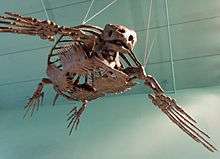Archelon
| Archelon Temporal range: Late Cretaceous, 80.5 Ma | |
|---|---|
 | |
| Mounted cast | |
| Scientific classification | |
| Kingdom: | Animalia |
| Phylum: | Chordata |
| Class: | Reptilia |
| Order: | Testudines |
| Suborder: | Cryptodira |
| Clade: | Americhelydia |
| Family: | †Protostegidae |
| Genus: | †Archelon Wieland, 1896 |
| Type species | |
| †Archelon ischyros Wieland, 1896 | |
- ARCHELON is also a sea-turtle conservation society, see ARCHELON, the Sea Turtle Protection Society of Greece
Archelon (from Greek αρχελών meaning ruler turtle) is a genus of extinct sea turtles, the largest genus of sea turtles that has ever been documented, and the second-heaviest turtles documented, behind Stupendemys.
Discovery

The first specimen of Archelon (YPM 3000) was collected from the Campanian-age Pierre Shale of South Dakota (a geological formation dated to 80.5 million years ago[1]) by Dr. G.R. Wieland in 1895 and described by him the following year (Wieland, 1896). The largest Archelon fossil, found in the Pierre Shale of South Dakota in the 1970s, measures more than 4 metres (13 ft) long, and about 4.9 metres (16 ft) wide from flipper to flipper. It was a marine turtle, whose closest living relative in the present day is the leatherback sea turtle.[2][3] Archelon lived at a time when a shallow sea covered most of central North America. Most of the known remains have been found in South Dakota and Wyoming. Though anatomically similar to the earlier species Protostega gigas, it was much larger.[4]
Biology

Unlike most modern turtles, Archelon did not have a solid shell, but instead had a skeletal framework supporting a leathery or bony carapace. Other distinguishing features include a pointed tail, a narrow skull, a relatively narrow, high-vaulted shell, and a pronounced overbite.[2] The live weight of an Archelon ischyros is estimated at more than 2200 kg (4,850 lb). They probably had a very strong bite, and were optimized for feeding on pelagic mollusks such as squid.[5] The specimen exhibited by the Museum of Natural History in Vienna is estimated to have lived to be a century old, and may have died while brumating on the ocean floor.[5]
References

- ↑ Carpenter, K. (2003). "Vertebrate Biostratigraphy of the Smoky Hill Chalk (Niobrara Formation) and the Sharon Springs Member (Pierre Shale)." High-Resolution Approaches in Stratigraphic Paleontology, 21: 421-437. doi:10.1007/978-1-4020-9053-0
- 1 2 http://www.uhaul.com/supergraphics/turtle/archelon.html
- ↑ "Archelon". BBC - Science & Nature. Retrieved 2009-05-25.
- ↑ Marine Turtles
- 1 2 BHI/Fossils & Minerals/Rept. and Amph./Archelon
Sources
- Hay, O. P. 1908. The fossil turtles of North America. Carnegie Institution of Washington, Publication No. 75, 568 pp, 113 pl.
- Wieland, G. R. 1896. Archelon ischyros: a new gigantic cryptodire testudinate from the Fort Pierre Cretaceous of South Dakota. American Journal of Science, 4th Series 2(12):399-412, pl. v.
- Wieland, G. R. 1902. Notes on the Cretaceous turtles, Toxochelys and Archelon, with a classification of the marine Testudinata. American Journal of Science, Series 4, 14:95-108, 2 text-figs.
- Wieland, G. R. 1906. The osteology of Protostega, Memoirs of the Carnegie Museum, 2(7):279-305.
- Wieland, G. R. 1909. Revision of the Protostegidae. American Journal of Science, Series 4. 27(158):101-130, pls. ii-iv, 12 text-figs.
| Wikispecies has information related to: Archelon |
| Wikimedia Commons has media related to Archelon. |
External links
- Black Hills Institute of Geological Research
- Oceans of Kansas Paleontology
- The Giant Archelon ischyros